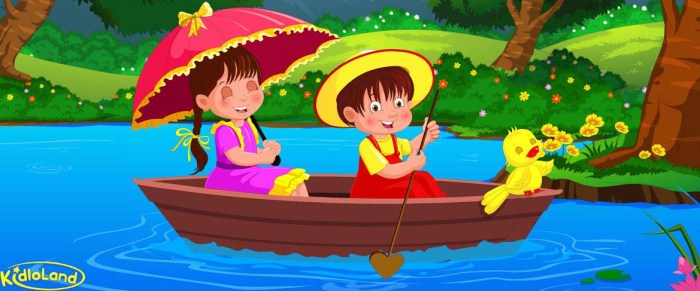Vessel for a Nursery Rhyme Trio: Unveiling the Metaphors and Symbolism invites readers to explore the captivating world of nursery rhymes, where vessels serve as profound metaphors for life’s journeys and experiences.
From the timeless tales of “Little Miss Muffet” to the whimsical adventures of “Humpty Dumpty,” vessels have played an integral role in shaping the imagination of generations. This comprehensive analysis delves into the historical origins, diverse types, and metaphorical meanings associated with vessels in nursery rhymes, offering a fresh perspective on these beloved classics.
Historical Origins of the Vessel in Nursery Rhymes
Vessels have played a significant role in nursery rhymes for centuries, serving as symbols of hope, exploration, and adventure. Their origins can be traced back to ancient folklore and oral traditions, where they represented the journey of life and the challenges faced along the way.
Early Nursery Rhymes Featuring Vessels
Some of the earliest known nursery rhymes featuring vessels include:
- “Rock-a-bye Baby” (1765):The cradle is depicted as a vessel, gently rocking the baby to sleep.
- “Row, Row, Row Your Boat” (18th century):The boat represents a journey, with the rowers working together to reach their destination.
- “Humpty Dumpty” (18th century):The egg is seen as a fragile vessel, symbolizing the vulnerability of life.
These rhymes illustrate the diverse ways in which vessels have been used to convey messages about life, death, and the human experience.
Types of Vessels in Nursery Rhymes

Nursery rhymes feature a diverse range of vessels, each with unique characteristics and functions that contribute to the storytelling.
Sailing Vessels
Sailing vessels, powered by wind, are common in nursery rhymes. They include:
- Ships:Large vessels capable of long voyages, often carrying passengers or cargo (e.g., “Little Miss Muffet,” “Sing a Song of Sixpence”).
- Boats:Smaller vessels used for fishing, transportation, or recreation (e.g., “Row, Row, Row Your Boat,” “This Little Boat”).
- Yachts:Luxury vessels used for pleasure or racing (e.g., “The Itsy Bitsy Spider”).
Rowing Vessels
Rowing vessels are propelled by oars or paddles:
- Rowboats:Small boats propelled by rowing (e.g., “Rock-a-bye Baby,” “The Owl and the Pussycat”).
- Gondolas:Narrow boats used in Venice (e.g., “There Was an Old Woman Who Lived in a Shoe”).
Flying Vessels
Flying vessels, while less common, add a fantastical element to nursery rhymes:
- Magic carpets:Carpets that can fly (e.g., “Aladdin”).
- Broomsticks:Used by witches to fly (e.g., “The Old Woman and the Broom”).
Metaphorical and Symbolic Meanings
Vessels in nursery rhymes often carry metaphorical and symbolic meanings, representing concepts beyond their literal significance. They can symbolize journeys, transitions, and life experiences, conveying hidden messages or lessons within the rhymes.
Journeys and Transitions
- Ships:Embarking on a ship often represents embarking on a journey, whether physical or metaphorical. Ships can symbolize exploration, adventure, or the journey of life itself.
- Boats:Boats are often associated with transitions or crossings, such as crossing a river or entering a new phase of life.
- Canoes:Canoes can represent a more solitary or personal journey, often involving self-discovery or inner exploration.
Life Experiences
- Pots and pans:Pots and pans can symbolize domesticity, cooking, and the nourishment of life.
- Cups and bowls:Cups and bowls can represent abundance, fertility, or the sharing of resources.
- Bottles:Bottles can symbolize secrets, messages, or the preservation of something valuable.
Comparative Analysis of Vessel Usage: Vessel For A Nursery Rhyme Trio

Nursery rhymes, with their enduring popularity across cultures and time periods, offer a unique lens through which to examine the diverse uses and meanings of vessels. This comparative analysis delves into the similarities and differences in vessel imagery found in nursery rhymes from various cultures, exploring the impact of cultural context on their interpretation.
Vessels, whether literal or metaphorical, serve as powerful symbols in nursery rhymes, often representing themes of containment, transformation, and journey. While their specific significance varies across cultures, certain commonalities emerge.
Cross-Cultural Similarities
- Containment and Protection:Vessels, such as cradles, baskets, and boats, frequently symbolize a safe and nurturing space, protecting the protagonist from external threats.
- Transformation and Growth:Vessels can also represent a transitional stage, facilitating personal growth and transformation. The act of entering or leaving a vessel often signifies a shift in the protagonist’s circumstances or identity.
- Journey and Adventure:Vessels often embark on journeys, carrying the protagonist into new and unfamiliar territory. These journeys may represent physical or metaphorical adventures, symbolizing exploration and self-discovery.
Cultural Variations
Despite these shared themes, the specific types and meanings of vessels in nursery rhymes vary significantly across cultures. For example, in European nursery rhymes, boats and ships are common vessels, reflecting the maritime traditions of these cultures. In contrast, in Asian nursery rhymes, baskets and cradles are more prevalent, reflecting the importance of family and domesticity in these societies.
The cultural context also influences the interpretation of vessel imagery. In Western cultures, boats are often associated with freedom and adventure, while in Eastern cultures, they may symbolize the journey of life or the cycle of rebirth.
Modern Interpretations and Adaptations

Contemporary nursery rhymes and adaptations often incorporate vessels to convey updated meanings and messages. These modern interpretations reflect the changing cultural and societal landscapes, exploring themes of diversity, inclusion, and environmental consciousness.
Evolving Symbolism of Vessels
In modern nursery rhymes, vessels continue to symbolize journeys, adventures, and personal growth. However, their symbolism has evolved to encompass a wider range of experiences and identities. For instance, a ship may represent not only a physical voyage but also a metaphorical journey of self-discovery or cultural exchange.
Vessels in Contemporary Themes, Vessel for a nursery rhyme trio
Modern nursery rhymes employ vessels to address contemporary themes such as:
- Diversity and Inclusion:Vessels can symbolize welcoming and embracing individuals from different backgrounds, cultures, and abilities.
- Environmental Consciousness:Nursery rhymes may use vessels to convey messages about protecting oceans, rivers, and other waterways.
- Social Justice:Vessels can represent safe spaces or vehicles for social change, empowering individuals to navigate challenges and advocate for justice.
Examples of Modern Adaptations
- “Row, Row, Row Your Boat”is adapted to promote diversity and inclusion: “Row, row, row your boat, gently down the stream. Everyone is welcome, no matter what it seems.”
- “The Little Ship That Could”is reimagined to address environmental consciousness: “I think I can, I think I can, save our precious ocean blue.”
- “I’m a Little Teapot”is adapted to convey a message of social justice: “I’m a little teapot, short and stout. I’m here to help, to speak out loud.”
Top FAQs
What is the significance of vessels in nursery rhymes?
Vessels in nursery rhymes often represent journeys, transitions, and life experiences, serving as metaphors for the challenges and triumphs we face.
How do different cultures interpret the symbolism of vessels in nursery rhymes?
Cultural context influences the interpretation of vessel imagery, with different cultures assigning unique meanings and associations to these objects.
How have modern interpretations updated the symbolism of vessels in nursery rhymes?
Contemporary adaptations of nursery rhymes often reinterpret the symbolism of vessels to reflect modern themes and experiences, making these classics relevant to new generations.